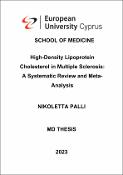Options
High-Density Lipoprotein Cholesterol in Multiple Sclerosis: A Systematic Review and Meta- Analysis
Author(s)
Palli, Nikoletta
Advisor(s)
Angouridis, Aris Dimitrios
Abstract
High-density lipoprotein cholesterol in multiple sclerosis: A systematic review and
meta-analysis (Under the supervision of Dr. Aris Dimitrios Angouridis; Steering Committee member
A: Dr. D. Papadopoulos; Steering Committee member B: Dr. C. Tsioutis)
Introduction: Multiple sclerosis (MS) is a chronic inflammatory disease of the central nervous system (CNS) and leads to demyelination and axonal degeneration. Evidence showed that lipid metabolism is associated with adverse clinical outcomes in MS.
Purpose: To systematically investigate all relevant evidence on the association between high-density lipoprotein cholesterol (HDL-C) and clinical parameters of disease activity in MS.
Methodology: The PubMed and Cochrane library databases were searched for studies with data on HDL-C in patients with MS. A qualitative synthesis of published prospective and retrospective studies for the role of HDL-C and other lipid profile
parameters in MS was performed. Additionally, a meta-analysis on HDL-C mean differences (MD) between Relapsing Remitting Multiple Sclerosis (RRMS) cases and healthy controls (HC) was performed.
Results: Literature search identified 13 potentially eligible trials evaluating the HDL-C of RRMS patients. In total, they included 1652 participants, 819 of which were RRMS patients, and 833 were HC. The pooled analysis demonstrated that RRMS patients had significantly lower HDL-C levels compared with the HC group (MD: -2.99 mg/dl,
95% CI: -5.19, -0.79, p = 0.008). Subgroup analysis did not reveal a significant HDLC concentration difference between RRMS and progressive MS patients (PMS) (MD:
0.34 mg/dl, 95%CI: [-2.66, 3.34], p = 0.82). Regarding triglycerides, pooled analysis from 11 studies (534 RRMS and 589 HC patients) showed significantly higher
triglyceride levels in RRMS compared with HC (MD: 22.99 mg/dl, 95% CI: 14.14, 31.83, p < 0.00001).
Conclusion: According to our results, low levels of HDL-C represent a potential biomarker of disease activity in MS. Future research opportunities in MS include investigating the role of lipids as potential indicators of disease burden and treatment
response biomarkers.
meta-analysis (Under the supervision of Dr. Aris Dimitrios Angouridis; Steering Committee member
A: Dr. D. Papadopoulos; Steering Committee member B: Dr. C. Tsioutis)
Introduction: Multiple sclerosis (MS) is a chronic inflammatory disease of the central nervous system (CNS) and leads to demyelination and axonal degeneration. Evidence showed that lipid metabolism is associated with adverse clinical outcomes in MS.
Purpose: To systematically investigate all relevant evidence on the association between high-density lipoprotein cholesterol (HDL-C) and clinical parameters of disease activity in MS.
Methodology: The PubMed and Cochrane library databases were searched for studies with data on HDL-C in patients with MS. A qualitative synthesis of published prospective and retrospective studies for the role of HDL-C and other lipid profile
parameters in MS was performed. Additionally, a meta-analysis on HDL-C mean differences (MD) between Relapsing Remitting Multiple Sclerosis (RRMS) cases and healthy controls (HC) was performed.
Results: Literature search identified 13 potentially eligible trials evaluating the HDL-C of RRMS patients. In total, they included 1652 participants, 819 of which were RRMS patients, and 833 were HC. The pooled analysis demonstrated that RRMS patients had significantly lower HDL-C levels compared with the HC group (MD: -2.99 mg/dl,
95% CI: -5.19, -0.79, p = 0.008). Subgroup analysis did not reveal a significant HDLC concentration difference between RRMS and progressive MS patients (PMS) (MD:
0.34 mg/dl, 95%CI: [-2.66, 3.34], p = 0.82). Regarding triglycerides, pooled analysis from 11 studies (534 RRMS and 589 HC patients) showed significantly higher
triglyceride levels in RRMS compared with HC (MD: 22.99 mg/dl, 95% CI: 14.14, 31.83, p < 0.00001).
Conclusion: According to our results, low levels of HDL-C represent a potential biomarker of disease activity in MS. Future research opportunities in MS include investigating the role of lipids as potential indicators of disease burden and treatment
response biomarkers.
Date Issued
2023-06-22
Department
School
Publisher
School of Medicine : MD Doctor of Medicine
File(s)
Loading...
Name
MD Thesis - Nikoletta Palli.pdf
Description
Master Thesis
Size
3.7 MB
Format
Checksum